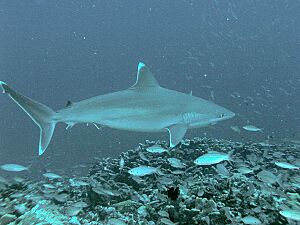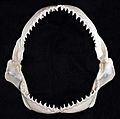Silvertip shark facts for kids
Quick facts for kids Silvertip shark |
|
|---|---|
 |
|
| Conservation status | |
| Scientific classification | |
| Kingdom: | |
| Class: | |
| Order: | |
| Family: | |
| Genus: | |
| Binomial name | |
| Carcharhinus albimarginatus |
|
 |
|
| Range of the silvertip shark | |
The silvertip shark (Carcharhinus albimarginatus) is a big type of shark found in the Indian and Pacific Oceans. It's easy to spot because of the cool white tips on its fins! These sharks usually grow to be about 2 to 2.5 meters (6.5 to 8 feet) long, but some can reach up to 3 meters (10 feet). They belong to a group called "requiem sharks."
Contents
What Does a Silvertip Shark Look Like?
The silvertip shark has a slim body and a long, rounded snout. Its eyes are big and round. It has a ridge between its two dorsal fins (the fins on its back). The first dorsal fin is large and pointy, starting just above or in front of its pectoral fins (the fins on its sides). The second dorsal fin is located above or just behind its anal fin (the fin near its tail). Its pectoral fins are large and curved, with rounded or pointed tips. The tail fin is uneven, with a larger upper part.
The top of the shark's body is dark grey or grey-brown, sometimes with a shiny bronze look. Its belly is white. It also has a faint white band along its side.
You might confuse the silvertip shark with other sharks. The grey reef shark looks similar, but it has dark tips on its pectoral and tail fins. The whitetip reef shark also has white markings on its dorsal and tail fins, but not on its pectoral fins. The whitetip reef shark also has a more square-shaped snout.
Silvertip sharks have 12 to 14 teeth on each jaw. Their upper teeth are wide and very jagged, perfect for catching prey!
Where Do Silvertip Sharks Live?
Silvertip sharks live in tropical oceans, often near continents, islands, and offshore banks. They love places with coral reefs and can be found in waters up to 800 meters (2,600 feet) deep.
You can find them in the western Indian Ocean, including the Red Sea and off East Africa. This includes places like Madagascar, Seychelles, and Mauritius. In the western Pacific Ocean, they are found from southern Japan all the way down to northern Australia and French Polynesia. In the eastern central Pacific, they live off southern Baja California, Mexico, down to Colombia, including islands like the Galápagos Islands.
Silvertip Shark Behavior
This shark is a skilled hunter and very sneaky. They are often seen in shallow waters, which makes them one of the more commonly spotted sharks. Because they can be unpredictable and hunt aggressively, they are considered more of a threat to humans than many other shark species.
How Silvertip Sharks Find Food

Silvertip sharks eat many different kinds of fish, including wahoo, eagle rays, wrasses, and tunas. They also hunt smaller sharks, octopuses, and squid. Sometimes, a silvertip shark has been seen swimming around other sharks that are feeding, and then taking food from them!
Silvertip Shark Reproduction
Silvertip sharks are viviparous, which means they give birth to live young, just like humans do. Their courtship can be a bit rough; they are known to hold onto each other, and bites are common. A female silvertip shark has even been found missing part of her dorsal fin after mating!
Mating usually happens in the summer. The mother shark carries her babies for up to a year. At first, the embryos get food from a yolk sac. Once the yolk is used up, the yolk sac changes into a special connection, like a placenta, that allows the babies to get food from their mother.
When they are born, there are usually 5 to 6 pups in a litter, but it can be anywhere from 1 to 11. Newborns are about 63 to 81 centimeters (25 to 32 inches) long. Female sharks are ready to have babies when they are about 2 meters (6.5 feet) long, and males are ready at about 1.8 meters (6 feet). Young pups often swim with their mother in shallow waters before they become independent.
Silvertip Sharks and Humans
Silvertip sharks can be somewhat dangerous. Records show that there have been four unprovoked attacks by these sharks on humans, but none of these attacks were deadly.
However, humans are a much bigger danger to silvertip sharks. These sharks are caught by fishing boats all over the world, sometimes on purpose and sometimes by accident. Their fins are very valuable for shark-fin soup, and their skin and cartilage are also sold.
Because silvertip sharks reproduce slowly, they are easily affected by too much fishing. This means they are vulnerable to overfishing. The IUCN has listed the silvertip shark as "Near Threatened". This means they are close to being considered a "vulnerable species" if their numbers keep dropping.
Silvertip sharks are caught by fisheries in countries like Indonesia, Myanmar, and the Philippines. In the Philippines, they are one of the top ten most caught shark species.
Images for kids
See also
 In Spanish: Tiburón de punta plateada para niños
In Spanish: Tiburón de punta plateada para niños








